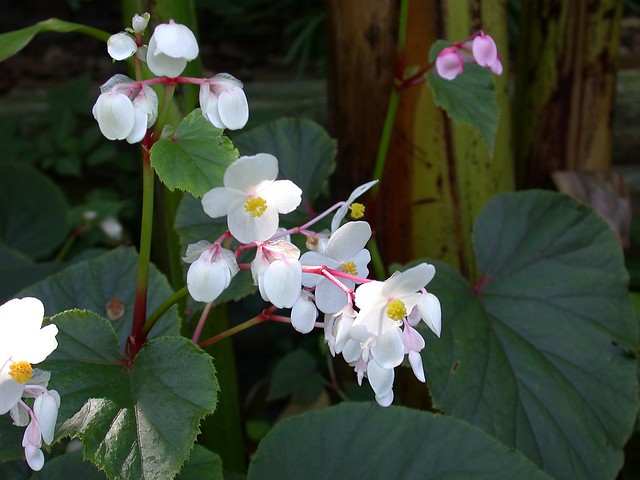
Begonia grandis, white-flowered form
Many gardeners are familiar with Begonia grandis (a.k.a. B. discolor, B. evansiana, B. sinensis), a tuberous species from China commonly known as the "hardy begonia". The name is well-earned: this truly is the hardiest species in a huge but mostly tropical and subtropical genus, going dormant in the winter and able to survive freezing temperatures into zone 6. But for a very long time, the most exciting news about hardy begonias was that they came in white as well as pink. In a genus with so many flashy plants, neither the foliage nor the flowers of B. grandis are terribly exciting. The leaves are handsome enough, and the pink or white flowers are nice coming so late in the season... and darn it, it's a hardy begonia. But hardiness is mostly what it has going for it, and is offset by the thing being downright weedy. It produces little aerial bulbils that act like seeds, dropping all over to produce a steadily-growing colony that will eventually crowd out smaller and slower-growing plants.
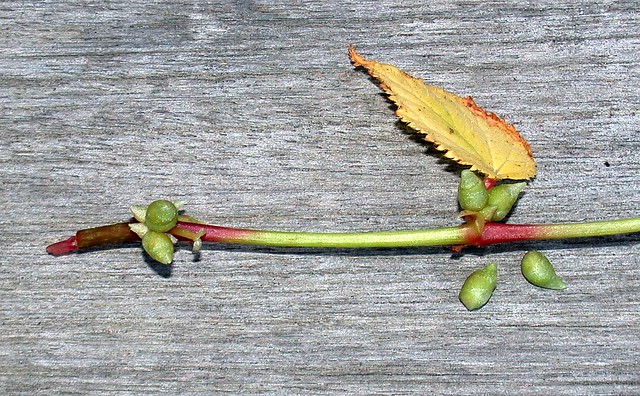
Begonia grandis bulbils
In the last decade or so, a few new cultivars of B. grandis have been making the rounds, representing slight variations in leaf size or color, flower color, and flowering time. But during the same period several other new begonias have been introduced, mostly from Asia, that have proven to be surprisingly hardy. Perhaps most surprising of all, most of these are not very closely related to B. grandis and look nothing like it. Many of these new begonias are rhizomatous (rather than tuberous) and are more closely related to "rex begonias", B. rex and its hybrids, and like that group are of interest primarily for their foliage.
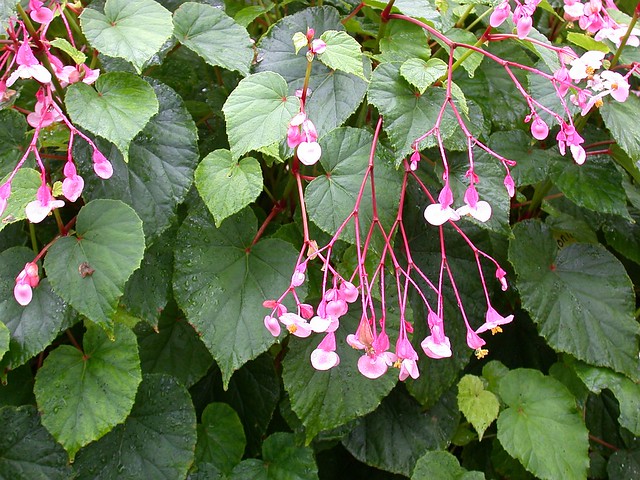
Begonia grandis 'Heron's Pirouette' at Plant Delights Nursery
Some of these have been trickling out to the public through nurseries like Plant Delights and now-legendary Heronswood. Others are in more limited cultivation, being traded among members of the American Begonia Society, but they deserve to be more widely grown. I've been trying many of these new introductions, and most have proven not only hardy but easy to grow. If anything, heat tolerance has proven to be more of a challenge than hardiness for me.
I'll keep descriptions and details brief; most of these can be found in other references, especially Mark Tebbitt's 2005 book Begonias: Cultivation, Identification, and Natural History, Derick Pitman's 2009 article in Pacific Horticulture, A Bounty of (Hardier) Begonias, and Dan Heims' In Search of Hardy Begonias on the Terra Nova Nurseries website. These excellent references pointed me towards trying most of the species and cultivars listed below. Several of them have now survived 2, 3, and even 4 winters in the ground in my zone 7a/b garden in Washington, DC. The most important thing to note is that all of the plants listed below survived the 2013-2014 winter--my area's coldest in 20 years, with a low temperature of 5 degrees F (-15 C)--with only a light mulch for protection. Some of these plants came back late and/or weakly, but the fact that they survived at all is pretty remarkable.
Begonia grandis 'Nanjiang Silver' was discovered in Sichuan, China by Dave Demers of Cyan Horticulture and named and distributed by Seattle Horticulturist Riz Reyes. This new collection of the species is sometimes listed as B. grandis subsp. holostyla. The plant's claim to fame is its generously silver-splashed foliage, normally a juvenile characteristic seen only on seedlings of this species. On 'Nanjiang Silver' the markings are prominent on the first leaves of the spring, but less so on leaves produced later in the season. I don't find 'Nanjiang Silver' to be a strong grower and it seems to be less heat tolerant than other B. grandis, tending to fall apart in hot weather. Riz has told me he regrets having distributed it for these reasons, but I'm glad he did because it shows great promise for breeding a new generation of hardy begonias with more interesting foliage.
 Begonia grandis 'Nanjiang Silver', spring foliage
Begonia grandis 'Nanjiang Silver', spring foliage
Begonia grandis 'Nanjiang Silver', flowers and late season foliage
Begonia 'Torsa' is a tuberous hybrid made sometime prior to 1981, resulting from a cross between B. grandis and a never-identified tuberous species from Bhutan that was probably a close relative. 'Torsa' is similar to B. grandis but larger in all dimensions. The plant does well both in the ground and in pots, and I'm not sure why such a great plant that has been around for so long is still so scarce in cultivation. 'Torsa' even produces bulbils, making it easy to propagate. Plants remain rather small and nearly indistinguishable from B. grandis during the first year, but really take off during the second and third growing seasons and produce very large foliage; one plant I grew had leaves 19 inches long and 14 inches wide (48 x 35.5 cm). The first leaves produced in the spring are the largest, but tend to be hidden under the smaller leaves it produces as it forms a flowering stem later in the growing season. 'Torsa' has a reputation for being mildew-prone but I've had no problems whatsoever.
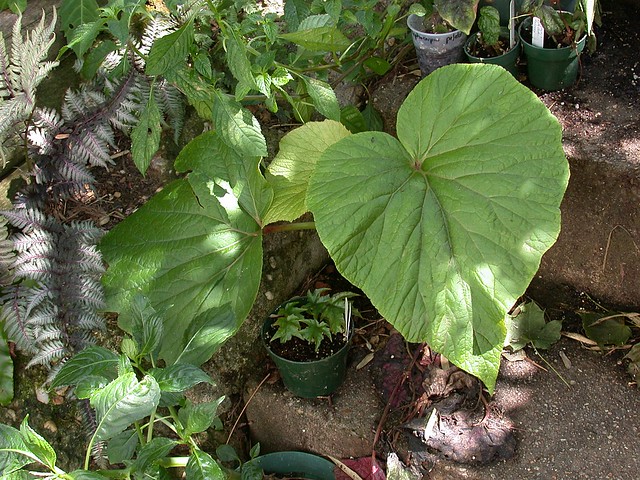
Begonia 'Torsa' spring foliage (scale: 4" pot in front)
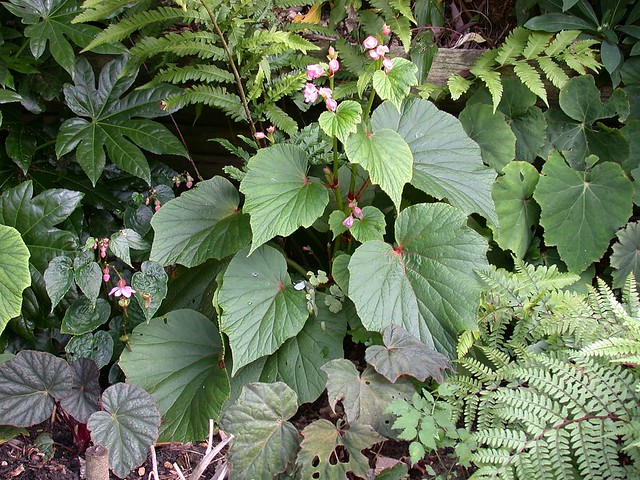
Begonia 'Torsa' in the garden
Begonia emeiensis is one of the hardiest of several species recently introduced from China. This species forms large colonies along streambanks in the wild and I find it requires much more water than most other begonias. The plant forms a fat rhizome at the soil surface, with leaves held high on long petioles. It blooms in the fall with large pink nodding flowers that tend to hide under the foliage. At its best, the leaves are quite large and deep green with a bluish iridescence. This can be a handsome species under the right conditions, which means full shade, high humidity, and never, ever drying out. It wilts if it dries out even slightly and in my own garden, the leaves nearly always end up a bit tattered and crispy around the edges. But it keeps coming back; my oldest clump has made it through the last 3 winters with minimal protection and just keeps spreading. It's also very easy to propagate from leaf cuttings and from the odd tuber-like bulbils it produces on its leaves. Hardiness and large foliage will make this species of interest to breeders.
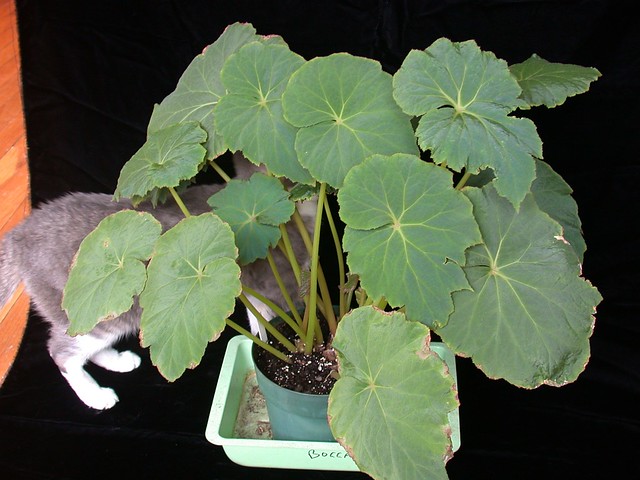
Begonia emeiensis, grown indoors (scale: 6 inch pot, 6 pound cat)
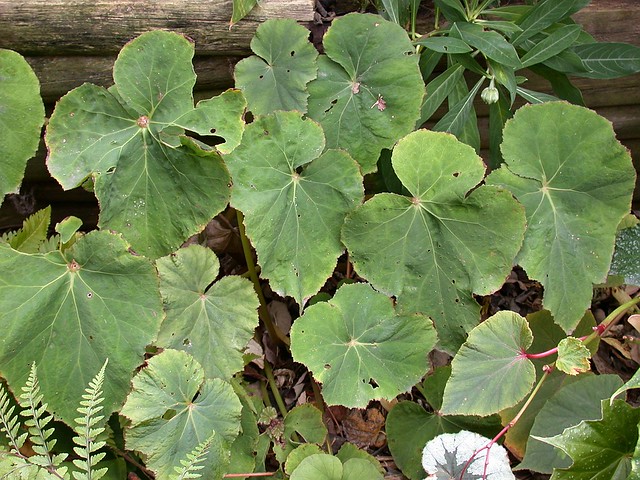
Begonia emeiensis in the late fall garden
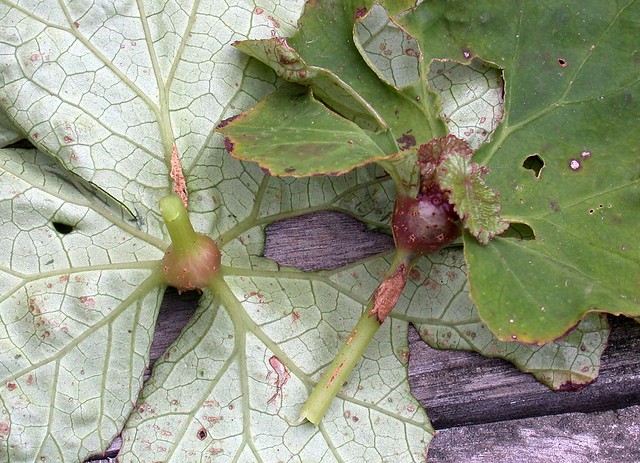
Begonia emeiensis leaves showing "bulbils"
Begonia pedatifida is a very different-looking begonia with deeply lobed leaves. This Chinese species is widespread and variable in the wild, and there are now several clones in cultivation. Unlike most of the other begonias listed here, which bloom in the late summer or fall, B. pedatifida is a late spring to early summer bloomer, flowering in June for me. I've had some difficulty propagating this species from leaf cuttings but it's otherwise easy to grow. My own plants haven't grown very large but at Plant Delights Nursery in Raleigh, North Carolina, I saw this species growing in enormous clumps; I believe these are a different clone than the one I'm growing.
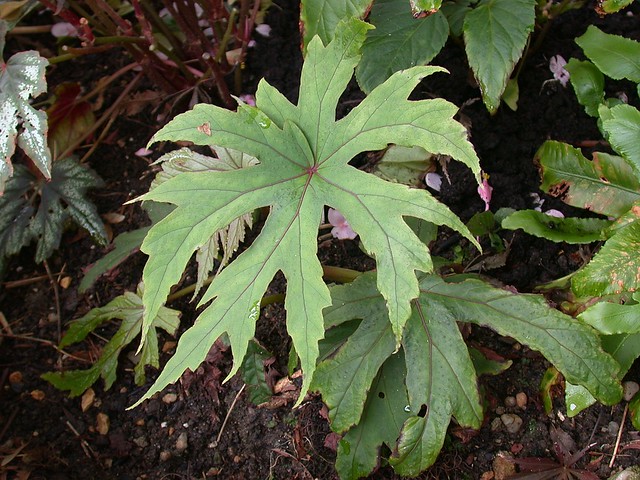
Begonia pedatifida
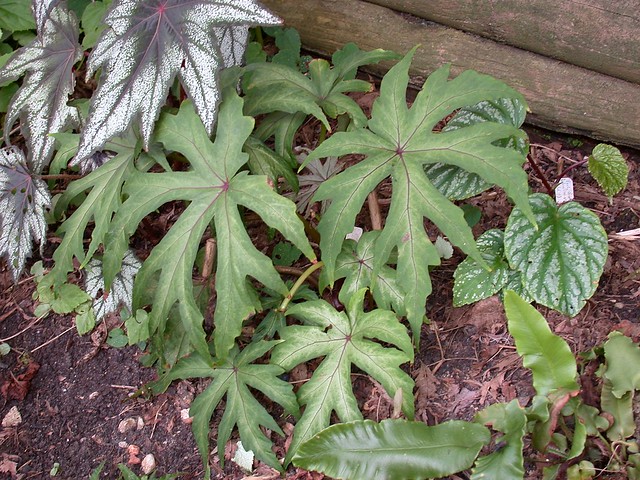
Begonia pedatifida
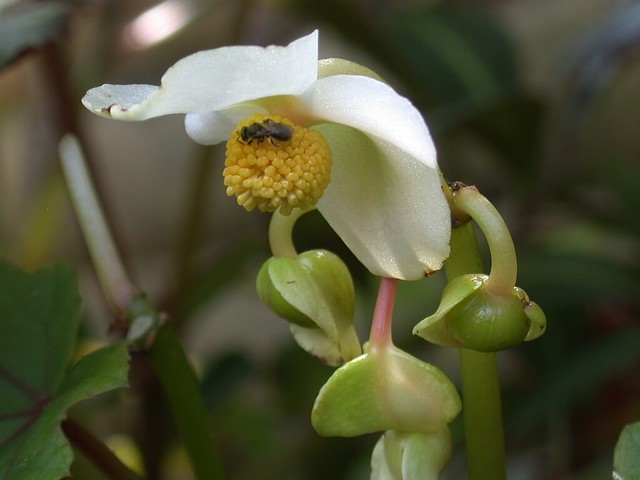
Begonia pedatifida, male flower
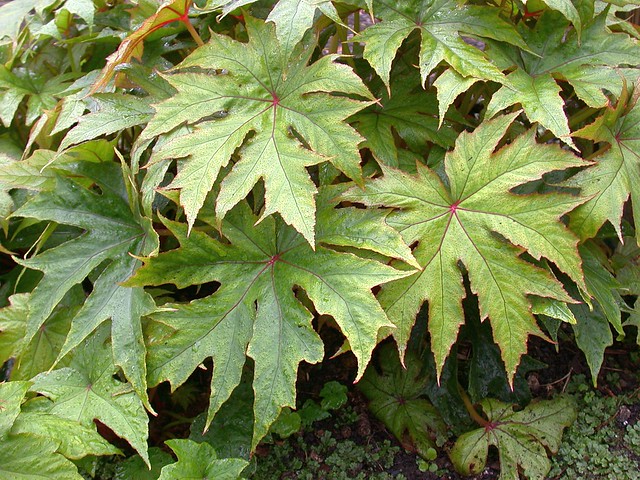
Begonia pedatifida at Plant Delights Nursery
Begonia chitoensis, a species from Taiwan, is another one with large, handsome foliage. This one really surprised me by surviving this past winter. As with several species listed here, B. chitoensis produces a rhizome that creeps along the soil surface, making it highly susceptible to freezing. In past years it has only returned from deeply buried sections of rhizome, but this spring it came back strong despite the much colder temperatures. Begonia chitoensis is very easy to grow, and even makes a nice houseplant. Introduced (misidentified) as B. ravenii, and still sometimes found under that name.
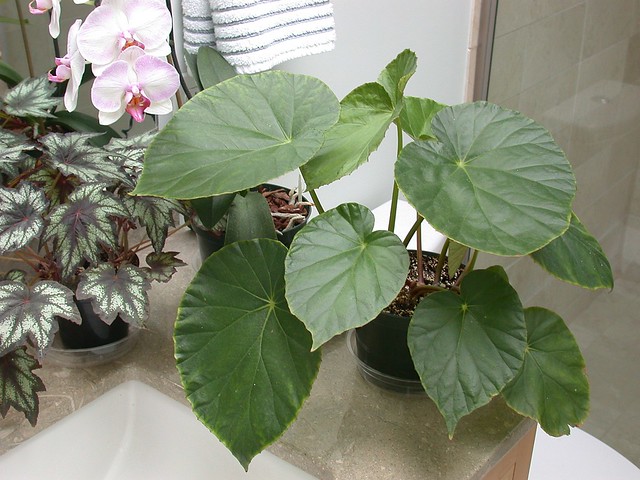 Begonia chitoensis, grown indoors
Begonia chitoensis, grown indoors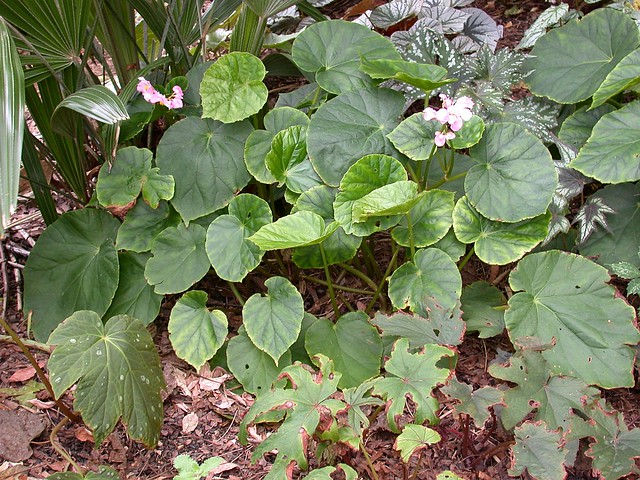
Begonia chitoensis in the garden
Begonia formosana grows in moist areas in its native haunts on Taiwan, but unlike B. emeiensis it has done quite well for me in ordinary garden soil with ordinary watering. Most populations in the wild have plain green leaves, but a few individuals here and there have leaves with white or silver speckles and these are the most desirable in cultivation. The speckles are most prominent on juvenile foliage but the glossy, deep green foliage remains attractive all summer. The plant forms a creeping rhizome from which erect stems emerge, holding the foliage well above the ground. The large pink flowers are produced in late summer and are pretty enough, but the foliage is the real star. I consider this one a real winner; it's not only hardy but comes back big and strong the following year.
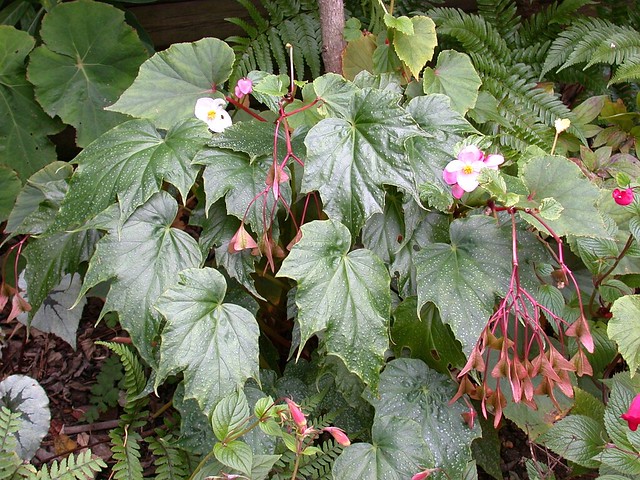 Begonia formosana (with seed capsules of B. grandis)
Begonia formosana (with seed capsules of B. grandis)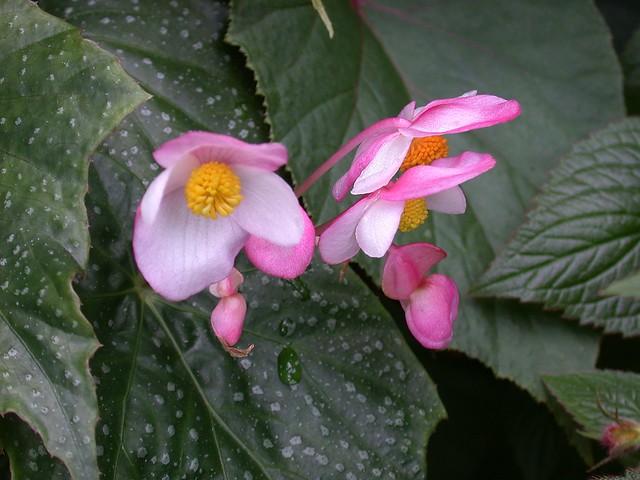
Begonia formosana, male flowers
Begonia palmata is a widespread and extremely variable species, and Mark Tebbitt has suggested that some of the higher-elevation collections should be tested for hardiness. There are now several different clones or collections in cultivation, some with quite beautiful foliage, that probably differ in hardiness. I've been growing one collection from northeastern India that has been hardy through 2 winters, but despite its hardiness I'm still deciding whether it's worth growing. Although the foliage is attractive and looks healthy, it's a slow grower and never amounts to much. I've had similar problems with several other species from northeastern India, which come mostly from higher elevations and probably require cooler summer temperatures than I can provide.
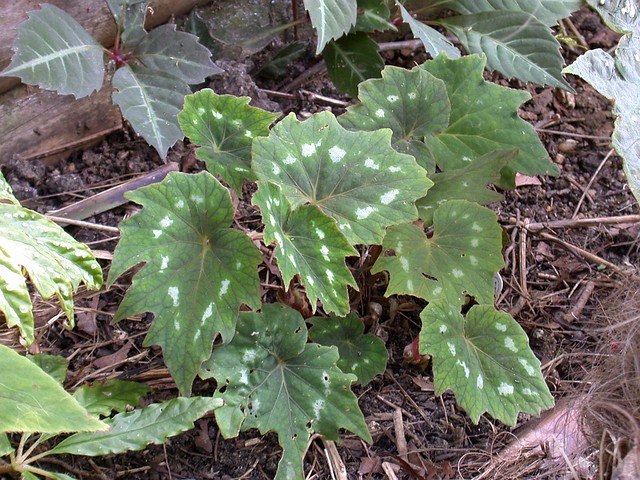
Begonia palmata
Begonia 'Metallic Mist' from Terra Nova Nurseries was the first of a new wave of hardy begonias from breeding programs that don't involve B. grandis . 'Metallic Mist' came from a cross between B. pedatifida and another Chinese species with spectacular foliage, B. taliensis. I picked up a plant at Plant Delights Nursery several years ago. While it proved quite hardy through several winters, I ultimately found it less than satisfying. The spring foliage was beautiful but the plant tended to look a bit tired later in the season, with a mounding habit I didn't care for. I've heard from other growers that its heat tolerance leaves something to be desired. Another Terra Nova introduction is 'Silver Splendor', which I haven't tried but saw growing at JC Raulston Arboretum. Terra Nova has recently come out with several more "hardy" begonias but I haven't yet trialed any of them; I'll be curious to see whether these plants, developed in the Pacific Northwest, can hold up to the brutally hot and humid summers of the east coast.
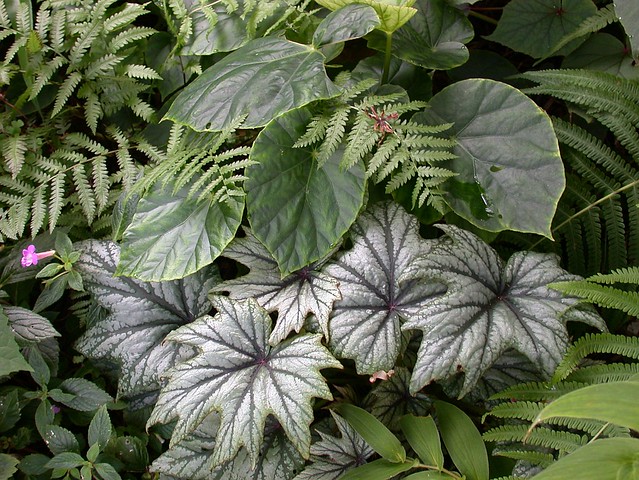
Begonia 'Metallic Mist' (growing with B. chitoensis)
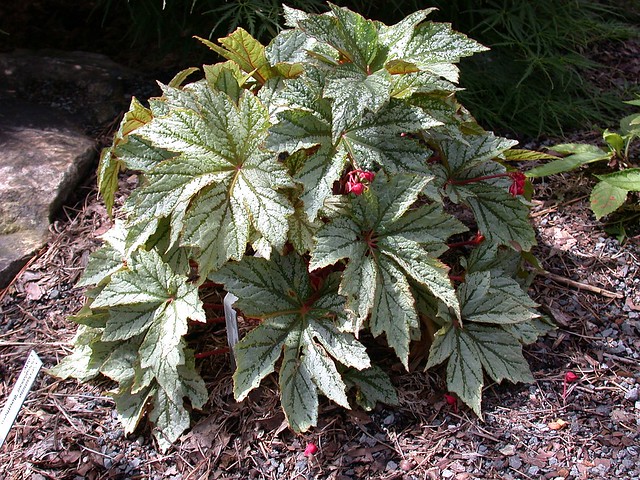 Begonia 'Silver Splendor' growing at JC Raulston Arboretum
Begonia 'Silver Splendor' growing at JC Raulston ArboretumI should also note that I've tried several begonias that have either proven not hardy, or have been otherwise disappointing. I tried for years to grow Begonia sutherlandii, a lovely tuberous species from South Africa with lovely orange flowers. Although the plants sometimes overwintered, they nearly always fell apart during hot summer weather. Begonia taliensis, one of the parents of 'Metallic Mist', is a spectacular plant that has done well in the U.K. but I've avoided it because it has a reputation for being intolerant of heat. I've tried the similar and closely related species B. muliensis, and while it lasted one (warm) winter in the ground, it struggled during the summer and petered out during its second growing season. One of the most beautiful begonias mentioned as hardy by Derick Pitman, 'Connee Boswell', did survive a mild winter but never grew well in my summer heat. I suspect my trouble with several other begonias reported as hardy is due to lack of heat tolerance.
One of my greatest disappointments has been B. hemsleyana, an unusual species recently introduced in a spectacular silver-spotted form; this has been suggested as hardy by Dan Heims but it has never done well for me. Plants grown indoors would tease me by growing well for a period, then collapsing practically overnight for no apparent reason. Grown outdoors, they barely survived the summer and never came back the following spring.
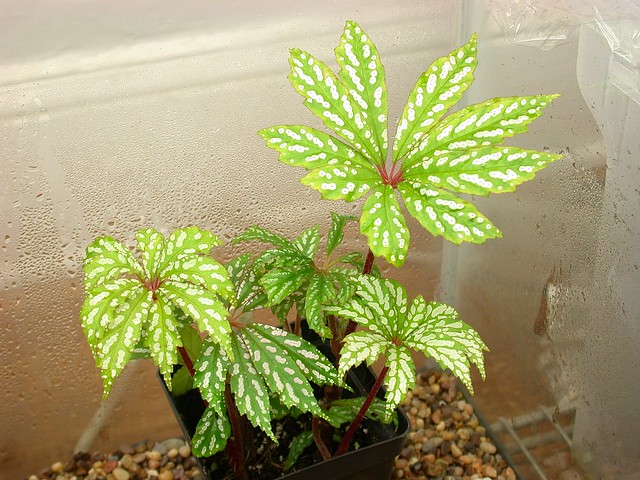
Begonia hemsleyana, a great disappointment
What's next for hardy begonias? I've barely scratched the surface here, as this is a huge and popular genus and new species and cultivars are introduced every year. Many of these have never been tested for hardiness, and it pays to experiment a bit. In another blog post, I'll talk about still more species and hybrids that I've discovered are hardy... some of them newly introduced, but some that have already been in cultivation for years! In the meantime, I would love to hear from others about your experiences with hardy(ish) begonias.
References
Begonias: Cultivation, Identification, and Natural History (Mark Tebbitt, Timber Press)
A Bounty of (Hardier) Begonias (Derick Pitman, Pacific Horticulture)
In Search of Hardy Begonias (Dan Heims, Terra Nova Nurseries)

We do love the word 'hardy', music to our ears! Exciting selection and a reference post to refer to. We have a few of the ones above and will keep an eye on the rest (hopefully they will trickle their way down here eventually...)
ReplyDeleteThe biggest question on my mind right now is why haven't I bought a Begonia pedatifida? That will be remedied this coming spring. Thanks for the information and photos! And you're right (your comment on my blog yesterday) no doubt a few will be sneaking into my garden...
ReplyDeleteI do love Begonias, and this is great news that there are hardier ones out there other than grandis. Now if I can just get my local wholesaler to carry these!
ReplyDeleteWell aren't you special? Thanks so much for putting all of this information here! Guess who will be buying some new plants?! I'm from the Caribbean and fell in love with begonia grandis several years ago when I saw it in a woodland garden.
ReplyDeleteMy garden has some hardy plants that remind me of the tropics, and I'd love to add more. Begonia grandis makes me smile every year since it not only is hardy, but fall-blooming. I adore it. It looks like there are more to adore, as well. Thanks for posting.
I grew my first annual begonia this summer. I'd always avoided them because I thought they were fussy. It ended up being one of the easiest plants in the garden. But I definitely don't have the moisture to grow them as perennials. I wish I did!
ReplyDeleteBeautiful.
ReplyDeleteWow, I had no idea there were so many hardy begonias to choose from. Beautiful!
ReplyDeleteSome exciting new hardy begonias! Looking forward to finding a few as they do like our cool Pacific Northwest summers.
ReplyDeleteAny idea who is selling B. 'Torsa'? I Goggled but found no sellers. Just planted B. grandis this past spring and had a nice floral display at summer's end. Tickled that it's a hardy Begonia.
ReplyDeleteBTW, congrats on your marriage in DC, from a husband of 32 years and 5 years married in MA. (museum people too ...)
I just purchased 'Torsa' from Annie's Perennials in California ( mail ordered).
DeleteWhat a lovely family begonia is, with so much variety! A very impressive post ... must have taken you AGES to research and write !!
ReplyDeleteBegonia sutherlandii needs a good mulch to survive winter, but holds up well here in shade. B. grandis is by far the most reliable for me. B. chitoensis and B. pedatifida have survived outdoors with mulch, but are more reliable and vigorous in a container. Maybe a bit of drying out occurred during summer.
ReplyDeleteJohn, this is a very well-done exposition on the topic. Thank you for the effort and sharing it. Any interest in getting a series done in The Begonian and letting even more people know about this growing option?
ReplyDeleteJohn, this is a very well-done exposition on the topic. Thank you for the effort and sharing it. Any interest in getting a series done in The Begonian and letting even more people know about this growing option?
ReplyDeleteWe have been growing /Begonia grandis/ in Minnesota, Zone 4, for many years. It has survived even this last winter with a week of -30F temperatures. It is available from the Friends School Plant Sale on Mothers Day weekend in Saint Paul.
ReplyDelete